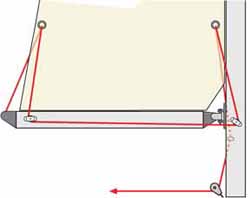I once bought a book on Sail Trim.
It was so complicated that it took me several years of sailing before I even had the vocabulary to read it. Even now I really just look at the pictures. Suffice it to say that sail trim is not really my thing. If you want your boat to go as fast as possible, get someone else to tell me what to do.
I’m really interested in how to set a sail plan that keeps the boat feeling stable and secure in any weather. And this often means running with less sail than you actually have, or with the sails running less efficiently.
The trouble is that sails are (shh! this is a well kept secret from landlubbers!!) not really triangular. Yes, they have three corners, but the edges are not always straight, and the middle kinda bulges a bit. It makes them a devil to fold up when you are not using them.
So if you want a big sail to be replaced by a little sail, you have two options. You can fold away a bit of it down one edge and tie that bit down firmly, or you can put the whole thing away in a bag and get a properly-shaped smaller one out. Racing boats have whole piles of sails in bags, and the crew get very used to taking one off and putting another on. And in fact even cruising sailors will carry special sails for very windy conditions – there is a storm jib in Flyer’s lockers right now. This article is interesting on the subject:
https://www.sailmagazine.com/cruising/storm-sails-do-you-need-them
I digress.
Me, I have two choices. I can make the sail smaller by folding it up, or I can let one of the corners or edges out so the whole thing goes a bit more saggy baggy and doesn’t work so hard when the wind gets too strong. I’m a big fan of this on the mainsail, the traveller is my friend. And generally I’ve learned how to do quite a bit with the ropes before the sail starts to flap horribly which wears it out and costs money and makes other sailors look at me sadly.
But in the end it’s time to make the sail smaller. The front sail is easy, you wrap it round the wire that holds it up. There is a price to pay for this, and that is that the sail itself needs to be a different shape – but on the plus side, once it’s reefed a bit I can see underneath it, which is useful.
The main sail is harder. You can fold up the bottom bit of the triangle to make it smaller, and in order to do this you drop the whole triangle down a bit. Sounds simple but it seems to involve a lot of string and sail flapping while you get it organised, and of course the reason you want to make the sail smaller is that it has got very windy, and trying to organise it in a wind makes it that bit harder.
 Flyer has what is called single-line slab reefing which is supposed to be super-simple and ideal for the solo sailor – drop the sail down a bit, pull in rope B (the red one in the diagram) to tuck in both ends of the bottom edge, job done. In practise it means that rope B is doing too many jobs, it goes round an extraordinary number of corners and through several pinch points. It gets stuck every time, and that’s not the sailor’s fault or the owner’s poor maintenance, it’s in the design.
Flyer has what is called single-line slab reefing which is supposed to be super-simple and ideal for the solo sailor – drop the sail down a bit, pull in rope B (the red one in the diagram) to tuck in both ends of the bottom edge, job done. In practise it means that rope B is doing too many jobs, it goes round an extraordinary number of corners and through several pinch points. It gets stuck every time, and that’s not the sailor’s fault or the owner’s poor maintenance, it’s in the design.
There are two Modern Innovations which provide alternatives. You can now wrap the mainsail round a vertical stick cunningly hidden inside the mast, or round a horizontal stick cunningly hidden inside the boom. When we started sailing 20 years ago the mast one was famous for getting stuck and the boom one was stupendously expensive and only used for very large boats. Also both involve compromises on sail design which means that your top speed is reduced.
I am very tempted. Time to read this: https://www.yachtingmonthly.com/sailing-skills/mainsail-furling-systems-an-expert-guide-75261
Gosh, are you still reading this? I thought I was here alone by now.
I’m sorry…what were we talking about?